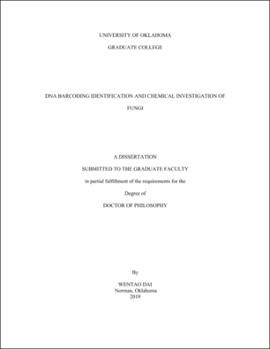| dc.description.abstract | Fungi represent a diverse resource in the discovery of new secondary metabolites which have been successfully developed as drugs such as antibiotics, immunosuppressant and stains. However, there are still problems which could potentially restrain the development of fungal natural products drug discovery, such as the confusing taxonomy annotation in NCBI, the deficiency of high capacity screening platforms as well as application of well recognized screening models, and the limited therapeutic diversity. With the aim to discover new fungal secondary metabolites, one efficient approach is to access new biodiversity. In this dissertation, we report the application of this approach in three chapters.
The kingdom Fungi is comprised of highly diverse taxa with an estimated of 2.2 - 3.8 million species on earth, of which only 5% have been described. Morphological characterization and DNA barcoding have served as the major strategies in fungal identification, with the latter considered as the universal tool. One of the growing problems of using DNA barcode data to identify fungi centers on the increasing number of GenBank sequence accessions that fall into the category of “insufficiently identified”. This has important implications for natural product chemical discovery since it is presumed that chemically unexplored fungal species are more likely to serve as sources of new natural products as opposed to well-known organisms whose secondary metabolomes have been thoroughly investigated. In this chapter, we propose a schema for using ITS barcode data to mine GenBank and identify high priority fungal isolates as potential sources of new natural products. In addition, we conducted a chemical analysis of one high-priority fungal isolate demonstrating that most of its major metabolites were previously unreported natural products.
The sexually transmitted parasite Trichomonas vaginalis infects at least 170 million people worldwide and infections are treated with the lone compound metronidazole, a suspected human carcinogen. Reports of resistance to the drug are increasing. Thus, new drug leads are needed with which to treat this and other anaerobic parasites. An assay was developed in order to quantify the growth, viability, and morphology of the Trichomonas organism, using the Perkin Elmer Operetta imaging platform. A counter-screen for toxicity was also developed using the normal human cervical cell line Ect1/E6E7 and the Operetta. Screening of a library of 430 pure compounds yielded compounds with selectivity indices (SI) as high as 14. Further screening of our fungal crude extract library and bioassay-guided isolation revealed many promising leads for potent anti-Trichomonas compounds that remain safe to human cells. The tetramic acid derivatives rose to the forefront, such as beauversetin (SI = 40), equisetin (SI = 20), and pyrrolocin A (SI = 167). Manipulation of oxygen levels revealed that beauversetin retained activity. An additional test against Lactobacillus acidophilus, a beneficial natural flora organism found in the genital tract, was used as a counterscreen. Growth in an anaerobic atmosphere revealed that tetramic acid derivatives like pyrrolocin A behaved like metronidazole and did not disrupt the growth of L. acidophilus.
Lastly, zebrafish has been utilized as a model organism for chemical screening to discover novel bioactive compounds. Phenotype-based zebrafish screening of a fungal crude extract library yielded an active fungal extract from a Penicillium sp. isolate. Bioassay-guided and chemistry-guided purification led to the identification of fourteen meroterpenoids including six new and seven known arisugacins and one known terrulactone. Their structures were determined using a combination of NMR and HRESIMS data, as well as the theoretical and experimental ECD spectra, and modified Mosher’s method. The purified compounds were tested in zebrafish embryos as well as in vitro for acetylcholinesterase inhibition activity. Compound 5.12 produced defects in myotome structure (metameric muscle which is critical for locomotion) in vivo and showed the most potent activity with an IC50 of 191 nM in vitro. This study demonstrates the utility of using zebrafish bioassay-guided sample purification as an effective strategy to rapidly identify bioactive small molecules with therapeutic applications. | en_US |
